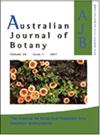气候变化或树木疾病:诊断森林死亡原因的挑战
IF 0.9
4区 生物学
Q4 PLANT SCIENCES
引用次数: 0
摘要
森林生态系统的组成和结构随着物种环境的变化而变化。极端气候事件和害虫/病原体正在推动这些生态系统的变化。确定两种潜在驱动因素中的哪一种导致了特定森林的死亡可能具有挑战性。在澳大利亚西南部,2011年森林大面积死亡的同时,气候极度炎热和干燥。它发生在历史上经历过疫霉肉桂根病(疫霉枯死病)的森林生态系统中。目的探讨北Jarrah森林疫霉枯死病病原菌P. cinnamomi是否与森林死亡有关。方法采用直接(病原分离)和间接(易感指示植物种调查)相结合的方法,对枯死林斑块内外进行调查。主要结果:死亡斑块与桂皮菌的存在之间没有一致的联系。33个对照样地和33个死亡样地中的3个分离到肉桂皮虫。虽然在死亡样地中没有几种对肉桂虫敏感的植物,但不同物种间的研究结果不一致。这可以用植物对高温和干旱的耐受性来解释。结论2011年北Jarrah森林发生的桂皮虫死亡事件并非其直接原因。极端气候事件引起的新干扰可以模拟某些害虫/病原体造成的损害。需要更多的研究来确定植物对极端温度和干旱条件的耐受性,以解开树木死亡的非生物和生物驱动因素。本文章由计算机程序翻译,如有差异,请以英文原文为准。
Climate change or tree disease: challenges for diagnosing causes of forest die-off
Context Forest ecosystems experience compositional and structural changes as species’ environmental envelopes shift with climate change. Extreme climate events and pests/pathogens are driving these ecosystem changes. Determining which of the two potential drivers is causing a particular forest die-off can be challenging. In south-western Australia, widespread forest die-off in 2011 coincided with extremely hot and dry conditions. It occurred in a forest ecosystem that has historically experienced Phytophthora cinnamomi root disease (Phytophthora dieback).Aims To determine whether the causal agent of Phytophthora dieback, P. cinnamomi, was associated with forest die-off in the Northern Jarrah Forest.Methods A combination of direct (isolation of pathogen) and indirect (survey of susceptible indicator plant species) measurements were taken inside and outside patches of forest experiencing the die-off.Key results There was no consistent association between die-off patches and the presence of P. cinnamomi. P. cinnamomi was isolated from 3 of 33 control plots and 3 of 33 die-off plots. Although several plant species susceptible to P. cinnamomi were absent from die-off plots, the findings were inconsistent across species. This may be explained by plant tolerance to high temperatures and drought.Conclusions P. cinnamomi was not the proximate cause of the observed die-off in the Northern Jarrah Forest in 2011.Implications Novel disturbance caused by extreme climate events can mimic damage caused by certain pests/pathogens. More research is needed to determine the tolerances of plants to extreme temperature and drought conditions to disentangle abiotic and biotic drivers of tree die-off.
求助全文
通过发布文献求助,成功后即可免费获取论文全文。
去求助
来源期刊

Australian Journal of Botany
生物-植物科学
CiteScore
2.30
自引率
18.20%
发文量
26
审稿时长
6-12 weeks
期刊介绍:
Australian Journal of Botany is an international journal for publication of original research in plant science. We seek papers of broad interest with relevance to Southern Hemisphere ecosystems. Our scope encompasses all approaches to understanding plant biology.
Australian Journal of Botany is published with the endorsement of the Commonwealth Scientific and Industrial Research Organisation (CSIRO) and the Australian Academy of Science.
 求助内容:
求助内容: 应助结果提醒方式:
应助结果提醒方式:


